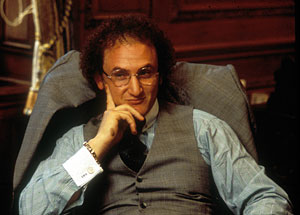Highlighting hair, from ‘Downton Abbey’ to Nicole Kidman

Simply sign up to the Life & Arts myFT Digest -- delivered directly to your inbox.
Autumn is the season not only of new looks on the catwalk but also of new looks on the small and silver screens as the television companies and Hollywood unveil their latest programmes and Oscar hopefuls. For what happens on TV and in cinemas can be at least as influential as what is shown on the runway. And as screen stylists strive to create believable characters, perhaps their most important craft or skill is hairstyling – and wigs.
Consider the example of Downton Abbey. Each series requires 30 or so wigs, each wig needing to be washed and restyled after every three days of filming. For the forthcoming new series Downton’s hair designer Magi Vaughan immersed herself in the early 1920s. “I looked at paintings, watched old films and got books from the 1920s with hair techniques such as the Marcel Wave,” she says. Literature also helped. “I read Bright Young People: The Rise and Fall of a Generation 1918-1940, by DJ Taylor and We Danced all Night by Martin Pugh. You get a lot from the text; for example, in the 1920s women were competitive about the sharpness of their bob.”
Or consider the example of Carey Mulligan, or, rather, consider the example of Carey Mulligan’s hair. Last year the sharp 1920s bob she modelled in The Great Gatsby was everywhere. This year “Carey is filming movies back to back so needs to wear wigs or it would wreck her hair and waste time on set,” says Michael Kriston, a hair designer who worked with Mulligan on the forthcoming Coen brothers’ film Inside Llewyn Davis.

Mulligan plays Jean Berkey, a hippy living in Greenwich Village in 1961 and, says Kriston, has hair based “on a brunette Mary Travers from Peter, Paul and Mary: long and uncut except for definite bangs across the front. I used a brown wig and wanted to leave the hair stringy so it wasn’t groomed, and put some highlights in to make it soft, so it wasn’t one solid colour. Otherwise it might look like a hat stuck on her head.”

For Nicole Kidman’s lead role in the forthcoming Grace of Monaco, key hair stylist Kerry Warn created four hairpieces. “The film isn’t a biopic but is all set in 1962, so we didn’t need lots of hair changes but we used hairpieces, such as chignons and braids, for the ball scenes,” says Warn, whose work with Kidman includes the latter’s Oscar-winning role in The Hours (2002). Warn was also a hair designer on The Great Gatsby, a follicular showcase featuring 300 extras – only 100 of whom sported their own hair. “Director Baz Luhrmann is very pro-hair, he loves it and wanted the styling to be extreme,” says Warn. “But, because he was shooting in 3D and HD, we had to be really careful about stray hairs, so it was a like a military procedure to keep each hair in place.”

According to hair colourist Lester Baldwin at John Frieda, “Producers will do almost anything to avoid having to pay for a wig; they can cost up to £30,000.” Such costs stem from the fact that one wig alone can take two to three months to make, being entirely stitched by hand. But, as Kriston points out, wigs can be necessary. “Often the actor’s hair won’t take the daily dying and styling,” says wig maker Amanda Miller. Besides, a wig can be changed, whereas an actor’s own hair can create problems.
When director Brian De Palma first saw Sean Penn’s transformation – via perm – into an Alan Dershowitz lookalike for the actor’s turn as lawyer David Kleinfeld in 1993 film Carlito’s Way, he was horrified.

“Sean is a frustrated hairdresser and got totally involved,” says Kriston. “We shaved his hair back on his forehead three inches, thinned it out, gave him a bald spot and permed it with old-lady pink rods for frizz. Brian thought he was getting a thirtysomething Sean Penn and when he saw him, with this crazy hair, he was not happy.” Penn and his hair, however, stole the show and the actor was nominated for his first Golden Globe.
Of course, the alternative could have been worse; “With men, you are often putting hair on very little hair or a bald head, so too high and it can look ridiculous, too low, Neanderthal,” explains Kerry Warn.
Historic hair can also be alienating. “For the hard-luck people in Boardwalk Empire, the hair looks greasy because at that time, people washed their hair maybe once a year,” says Kriston, whose hair design for the Martin Scorsese-directed pilot episode earned him one of his three Primetime Emmy nominations. “I focused on creating very dirty hair using a combination of sea salt spray and a light pomade, or, in a few cases, wigs.”
Purposely bad hair can be useful, too. For the forthcoming The Wolf of Wall Street, starring Leonardo DiCaprio, Kriston designed a terrible toupee for one broker. “In his book, Jordan Belfort, [the DiCaprio lead] called his fellow financier ‘Wig Wam’ because even though he was making $3m a week, he was still wearing a $200 toupee,” says Kriston. “I had a lot of fun with that character.”
Comments